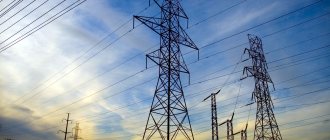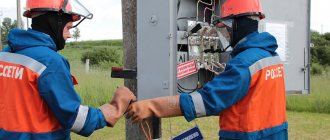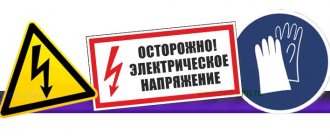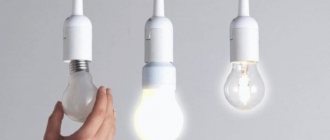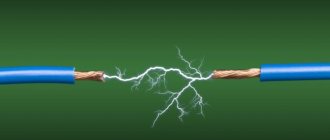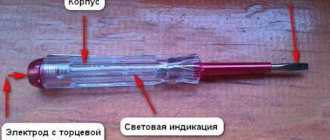Area of influence
The first rules for working in the electrical field began to be published even before the appearance of the USSR in Tsarist Russia. The largest number of norms were created during the existence of the USSR. They then acted equally on the territory of all republics.
After the collapse of the Soviet Union, most countries did not deviate from the already written chapters, but were given the opportunity to make independent changes. In this regard, the latest editions of the Russian Federation, Belarus and Ukraine differ, albeit slightly. Thus, today Russia has its own list of PUEs, which are valid only on its territory.
Liability for non-compliance
Each country sets its own penalties. In Russia things are as follows:
- Civilian . If violations are detected, the citizen will receive a fine of 1 to 2 thousand rubles.
- Officials . A person holding a certain position at an enterprise, if violations are detected, receives a fine of 2 to 4 thousand rubles.
- Entrepreneurs . If the entrepreneur is not registered as a legal entity. person, then the punishment in relation to him is softened: from 2 to 4 thousand rubles fine and suspension of activities for up to 90 days.
- Legal entities . They receive the heaviest punishment in the form of a fine of 20 to 40 thousand rubles and suspension of activities for up to 90 days.
Pre-revolutionary time and pre-war period
- 1899 - the first All-Russian Electrotechnical Congress was held.
- 1900-1909 - holding the second - sixth All-Russian Electrotechnical Congresses without any special changes to the rules.
- 1910 - 1911 - the breakthrough Seventh All-Russian Congress. Installed:
- Rules for the production and operation of high-current devices.
- Rules for operating high voltage installations.
- Rules for organizing electrical equipment in crowded areas.
- Rules for installing overhead power lines.
- Rules for working with cables and electrical equipment during fire fighting.
- Publication of safety rules and rules for the construction of installations with high operating currents for low and high voltages.
Almost throughout this entire period, publications were published under the long title “Safety Rules and Electrical Installation Rules.” Then information about the device was written out separately, and the main list was occupied by security. Later, in the process of improving electrical installations, the standards began to be generalized and issued in the form of one list of items.
Electrical Installation Rules (PUE) current version for 2022
Rules for the Construction of Electrical Installations PUE - a group of all-Union regulatory documents of the USSR Ministry of Energy, regulatory documents of the Russian Ministry of Energy and documents of other countries. Rules for the design of electrical installations PUE apply to newly constructed and reconstructed electrical installations of direct and alternating current with voltage up to 750 kV, including special electrical installations... PUE is a document that is used along with GOSTs, SP and SNiPs by design engineers, electricians and other workers whose activities are related to electrical installations, engineering networks and communications.
Rules for the Construction of Electrical Installations PUE is not a document in the field of standardization and is not a single document and was published in separate chapters, one of which was called “General Part” and established general requirements. Collections of PUE documents were published under the name “editions”.
Status of PUE for 2022 in the countries of the former USSR:
— in the Russian Federation, the current chapters 6 and 7 of the PUE are valid as of 01/01/2022;
— TKP 339-2011 is valid in the Republic of Belarus, introduced for the first time in 2011 to replace a number of chapters of the PUE 6th edition and its remaining chapters;
— in Ukraine, the 2009 PUE is valid (similar to the 7th edition).
RULES FOR CONSTRUCTION OF ELECTRICAL INSTALLATIONS PUE are valid in the Russian Federation in the form of separate sections and chapters 7 and 6 of the edition
| PUE (6th edition) | PUE (7th edition) |
| Section 1. General rules | Section 1. General rules |
| Chapter 1.3. Selection of conductors by heating, economic current density and corona conditions Chapter 1.4. Selection of electrical devices and conductors according to short circuit conditions Chapter 1.5. Electricity metering Chapter 1.6. Electrical measurements | Chapter 1.1. a common part Chapter 1.2. Power supply and electrical networks Chapter 1.7. Grounding and protective electrical safety measures Chapter 1.8. Acceptance testing standards Chapter 1.9. Insulation of electrical installations |
| Section 2. Electricity sewerage | Section 2. Electricity transmission |
| Chapter 2.1. Electrical wiring Chapter 2.2. Current conductors with voltage up to 35 kV Chapter 2.3. Cable lines with voltage up to 220 kV | Chapter 2.4. Overhead power lines with voltage up to 1 kV Chapter 2.5. Overhead power lines with voltages above 1 kV. Order of the Ministry of Energy of Russia dated December 20, 2017 No. 1197 “On the exclusion of paragraph 2.5.223 of Chapter 2.5 “Overhead power lines with voltages above 1 kV” of Section 2 of the Rules for the Construction of Electrical Installations, seventh edition, approved by Order of the Ministry of Energy of Russia dated May 20, 2003 No. 187” |
| Section 3. Protection and automation | |
| Chapter 3.1. Protection of electrical networks with voltage up to 1 kV Chapter 3.2. Relay protection Chapter 3.3. Automation and telemechanics Chapter 3.4. Secondary circuits | |
| Section 4. Switchgears and substations | Section 4. Switchgears and substations |
| Chapter 4.3. Converter substations and installations Chapter 4.4. Battery installations | Chapter 4.1. Switchgears with voltage up to 1 kV AC and up to 1.5 kV DC Chapter. 4.2. Switchgears and substations with voltage above 1 kV |
| Section 5. Electric power plants | |
| Chapter 5.1. Electrical machine rooms Chapter 5.2. Generators and synchronous compensators Chapter 5.3. Electric motors and their switching devices Chapter 5.4. Crane electrical equipment Chapter 5.5. Electrical equipment of elevators Chapter 5.6. Capacitor installations | |
| Section 6. Electric lighting | |
| Chapter 6.1. a common part Chapter 6.2. Interior lighting Chapter 6.3. Outdoor Lighting Chapter 6.4. Illuminated advertising, signs and illumination Chapter 6.5. Lighting control Chapter 6.6. Lighting devices and electrical installation devices | |
| Section 7. Electrical equipment of special installations | Section 7. Electrical equipment of special installations |
| Chapter 7.3. Electrical installations in hazardous areas Chapter 7.4. Electrical installations in fire hazardous areas Chapter 7.7. Peat electrical installations | Chapter 7.1. Electrical installations of residential, public, administrative and domestic buildings Chapter 7.2. Electrical installations of entertainment enterprises, clubs and sports facilities Chapter 7.5. Electrothermal installations Chapter 7.6. Electric welding installations Chapter 7.10. Electrolysis plants and electroplating plants. Order of the Ministry of Energy of Russia dated December 20, 2017 No. 1196 “On recognizing certain provisions of the Electrical Installation Rules as not subject to application” – paragraphs 1 and 6 of clause 7.1.34. The requirements of clause 7.1.34 of the PUE, which prescribed the use of cables and wires with copper conductors in electrical installations of buildings, were recognized as not subject to application. |
The current version of the PES does not take into account the simultaneously existing requirements for the protection of electrical installations:
- GOST R 50571.17-2000 (IEC 60364-4-482-82) Electrical installations of buildings. Part 4. Security requirements. Chapter 48. Selection of protective measures depending on external conditions. Section 482. Fire protection,
- GOST R 50571-4-44-2011 (IEC 60364-4-44:2007) Low-voltage electrical installations. Part 4-44. Security requirements. Protection against voltage fluctuations and electromagnetic interference.
After the adoption of the Law “On Technical Regulation” dated December 27, 2002 N 184-FZ (as amended on November 28, 2018), the Ministry of Justice refused to register twenty-three new chapters of the seventh edition of the PUE.
In 2016, Law No. 196-FZ dated June 23, 2016 “On Amendments to the Federal Law “On Electric Power Industry” in terms of improving the requirements for ensuring the reliability and safety of electric power systems and electric power facilities” was adopted, establishing requirements for:
- the functioning of electric power systems, including ensuring the stability and reliability of electric power systems, modes and parameters of operation of electric power facilities and power receiving installations, relay protection and automation, including emergency and regime automation;
- functioning of electric power facilities and energy receiving installations;
- planning the development of electric power systems;
- safety of electric power facilities and energy receiving installations;
- training workers in the electric power industry to work at electric power facilities and power receiving installations.
The changes also provide that the requirements for the equipment of electric power facilities and power receiving installations as products are established in accordance with the law of the Eurasian Economic Union and the legislation of the Russian Federation.
Currently, there are national technical regulations establishing requirements for consumer electrical installations and electrical equipment:
- Federal Law of December 30, 2009 N 384-FZ “Technical Regulations on the Safety of Buildings and Structures” (as amended on July 2, 2013),
- SP 76.13330.2016 Electrical devices. Updated edition of SNiP 3.05.06-85,
- SP 256.1325800.2016 “Electrical installations of residential and public buildings. Rules for design and installation",
- Federal Law of July 22, 2008 N 123-FZ “Technical Regulations on Fire Safety Requirements” (as amended on December 27, 2022).
- “Safety rules for power receiving installations. Features of electrical wiring in buildings with conductive copper conductors or conductors made of aluminum alloys.” Approved by Order of the Ministry of Energy of Russia dated October 16, 2017 No. 968. The corresponding requirements of the PUE were recognized as not subject to application from December 2022.
For products for which the technical regulations of the Customs Union or the technical regulations of the Eurasian Economic Community have not entered into force, the norms of the legislation of the Customs Union and the legislation of the Parties in the field of technical regulation apply. At the moment, the PUE does not apply to Russian legislation in the field of technical regulation.
Currently in the Russian Federation there are technical regulations of the Customs Union related to electrical installations:
- TR TS 004/2011 On the safety of low-voltage equipment (as amended on October 25, 2016);
- TR TS 012/2011 On the safety of equipment for work in explosive environments;
- TR CU 020/2011 Electromagnetic compatibility of technical equipment (as amended on February 3, 2015).
On this topic
List of products for which the submission of a customs declaration is accompanied by the submission of a conformity assessment document (information about the conformity assessment document) to the requirements of TR CU 004/2011 (as amended as of March 19, 2019)
Rules for the technical operation of electrical installations of PTEEP consumers (as amended as of September 13, 2022)
Rules for labor protection during the operation of electrical installations POTEE. approved by order of the Ministry of Labor of the Russian Federation dated December 15, 2020. N903н
Rules for labor protection during the operation of heat supply facilities and heat-consuming installations POTET, approved by order of the Ministry of Labor of the Russian Federation dated December 17, 2020 No. 924n
Popular goods
Copper braided tires
Insulated tires flexible and hard
Tire holders
Insulators
Voltage indicators
Post-war USSR
After a long break, the relevant authorities of the post-war USSR almost immediately began to further regulate standards in the field of production and operation of electrical installations. The forthcoming progress of industry and the increase in production capacity only accelerated the process.
This period has an important feature. At that time, the USSR did not adopt separate laws to control and regulate this industry. Each change in the structure and content of the document was made by orders of individual ministers or resolutions of the entire Council of Ministers.
Initially, the rules for electrical installations were part of the design and construction standards . They were given a separate place in the document under the designations SNiP and SN:
- SN 174-67 Design of power supply for industrial enterprises;
- SN 174-75 Design of power supply for industrial enterprises;
- SN 357-77 Power and lighting electrical equipment of industrial enterprises: design instructions.
- CH 4-57 Section XIII. Electric installation work. Technical conditions for the production and acceptance of construction and installation works.;
- SN 100-60 Section 13. Overhead power lines. Part III. Technical conditions for the production and acceptance of installation and construction works.;
- SN 70-59 Section 13. Cable lines and electrical wiring. Part II Technical conditions for the production and acceptance of construction and installation works;
- SNiP III-I.6-62 Electrical devices. Rules for organizing and conducting work. Transfer into operation;
- SNiP III-I.6-67 Electrical devices. Rules for production and organization of work. Transfer into operation;
- SNiP III-33-76 Electrical devices;
- SNiP 3.05.06-85 Electrical devices.
Departmental standards:
- VSN-342-75 Installation of high-voltage power transformers with voltage up to 110 kV.
- VSN 59-88 Electrical equipment of public and residential buildings.
- SP 31-110-2003 Design and installation of electrical installations in public and residential buildings.
Process design standards:
- ONTP 5-78 Technological design of high voltage substation 35-750 kV;
- RUP-1964 Features and standards for designing installations in rural areas;
- NTPS-67 Technological design of electrical networks and power plants in rural areas;
- NTPS-88 Technological design of electrical networks for agricultural purposes;
- NTPD-90 Technological design of diesel power plants;
- VNTP-81 Technological design of thermal power plants;
- Technological design of points and units for the work of dispatchers of SDTU power systems.
individual publications of the PUE were also actively published and supplemented with the development of the industrial sector:
- PUE - 1st edition . Rules for the construction of electrical installations. For three years (from 1946 to 1949) it was published in the form of separate small brochures. In 1949, it was decided to combine these brochures and publish them in a single publication. Additional section changes were issued separately in 1950.
- PUE - 2nd edition . It was released in 1950 without significant changes in content. The appearance of the brochure has been greatly changed. In 1952, an additional section entitled “Electric Welding” was published.
- PUE - 3rd edition . Issued in separate sections starting in 1957. The entire book was completed only in 1964.
- PUE - 4 editions . In 1965, the fourth edition was released in its entirety, which was essentially the third with minimal changes.
- PUE - 5th edition . Separate issues began to be published in 1976. The final one was released in 1982.
- PUE - 6th edition . The development was carried out by the Ministry of Energy of the Soviet Union itself. The fully finished version went into use in the summer of 1985. In the fall, an important change was made, but they did not make another reissue, canceling the effect of a specific controversial paragraph.
"Rules for electrical installations"
The electrical installation rules operate in the form of separate sections and chapters of the seventh edition and current sections and chapters of the sixth edition. “Rules for the construction of electrical installations” (PUE) of the seventh edition, due to the long period of processing, are issued and put into effect in separate sections and chapters as work on their revision, coordination and approval is completed.
Section 1. General rules.
- Chapter 1.1. a common part
- Chapter 1.2. Power supply and electrical networks
- Chapter 1.3. Selection of conductors by heating, economic current density and corona conditions
- Chapter 1.4. Selection of electrical devices and conductors according to short circuit conditions
- Chapter 1.5. Electricity metering
- Chapter 1.6. Electrical measurements
- Chapter 1.7. Grounding and protective electrical safety measures
- Chapter 1.8. Acceptance testing standards
- Chapter 1.9. Insulation of electrical installations
Section 2. Electricity sewerage. Electricity transmission.
- Chapter 2.1. Electrical wiring
- Chapter 2.2. Current conductors with voltage up to 35 kV
- Chapter 2.3. Cable lines with voltage up to 220 kV
- Chapter 2.4. Overhead power lines with voltage up to 1 kV
- Chapter 2.5. Overhead power lines with voltage above 1 kV
Section 3. Protection and automation
- Chapter 3.1. Protection of electrical networks with voltage up to 1 kV
- Chapter 3.2. Relay protection
- Chapter 3.3. Automation and telemechanics
- Chapter 3.4. Secondary circuits
Section 4. Switchgears and substations
- Chapter 4.1. Switchgears with voltage up to 1 kV AC and up to 1.5 kV DC
- Chapter. 4.2. Switchgears and substations with voltage above 1 kV
- Chapter 4.3. Converter substations and installations
- Chapter 4.4. Battery installations
Section 5. Electric power plants
- Chapter 5.1. Electrical machine rooms
- Chapter 5.2. Generators and synchronous compensators
- Chapter 5.3. Electric motors and their switching devices
- Chapter 5.4. Crane electrical equipment
- Chapter 5.5. Electrical equipment of elevators
- Chapter 5.6. Capacitor installations
Section 6. Electric lighting
- Chapter 6.1 General part
- Chapter 6.2. Interior lighting
- Chapter 6.3. Outdoor Lighting
- Chapter 6.4. Illuminated advertising, signs and illumination
- Chapter 6.5. Lighting control
- Chapter 6.6. Lighting devices and electrical installation devices
Section 7. Electrical equipment of special installations.
- Chapter 7.1. Electrical installations of residential, public, administrative and domestic buildings
- Chapter 7.2. Electrical installations of entertainment enterprises, clubs and sports facilities
- Chapter 7.3. Electrical installations in hazardous areas
- Chapter 7.4. Electrical installations in fire hazardous areas
- Chapter 7.5. Electrothermal installations.
- Chapter 7.6. Electric welding installations.
- Chapter 7.7. Peat electrical installations
- Chapter 7.8.-
- Chapter 7.9.-
- Chapter 7.10. Electrolysis plants and electroplating plants.
Site sections related to this document:
- Design
- Electrical repair and electrical measuring work
- Training in labor protection, fire safety and electrical safety, thermal power engineering
Russian Federation
It is easy to guess that at the end of the 80s and after the collapse of the USSR, no significant changes were made to the PUE for obvious reasons. At the same time, the existing set of rules was more than enough and they did not lose their legal force. In 1994, the rules for electrical installations corresponded to the Gosstandart of Russia and Gosenergonadzor. In 1995, the PUE was approved by the Ministry of Fuel and Energy and became part of departmental regulatory documents. As a result, new changes began to be made to the document on behalf of this organization in 1997 and 1998.
Since 2000, the first serious changes since 1985 have been introduced into the PUE. The sections “Electrical lighting” and “Electrical equipment of special installations” are added. In 2003, the last major changes were introduced: sections “General Rules”, “Electricity Transmission”, “Switchgears and Substations” appeared.
With the departure of the USSR, important changes occurred in the legal component of the process. According to the constitution, federal electrical installations became the responsibility of the Russian Federation. As a result, starting from 2003, all existing standards must comply with the legislation of the Russian Federation. Individually issued regulations have a direct impact on existing reliability and safety requirements. Since 2016, regulatory and legal acts have put forward requirements for all sectors of the electric power industry: electrical installations, power lines, industrial facilities, residential premises, training of personnel and specialists to service all electrical systems.
As for the PUE, today the 6th and 7th editions with the latest amendments are relevant in the Russian Federation. Their use is fully consistent with existing regulations. The content includes rules based on centuries of experience in the development of electrical installations, including the latest developments, technologies and optimal solutions. Strict adherence to these standards guarantees safety and high efficiency of the technology.
Where the Rules for the Construction of Electrical Installations, PUE, apply
Many people call the PUE the reference book for all electricians. This is actually true, but not entirely. The PUE book has limited validity and cannot, of course, be used for all electrical installations.
The PUE is valid for electrical installations whose voltage does not exceed 750 kV.
The PUE applies to newly constructed electrical installations, as well as to electrical installations undergoing reconstruction. Moreover, if the reconstruction takes place in part of the building (electrical installation), and the second part is in normal operation, the PUE applies only to the reconstructed part.
Some clarification is required here. In the PUE book, and in all regulatory documents, electrical installations refer to lines, devices, machines, together with their installation premises, intended for all stages of the production and use of electrical energy.
In practice, there are practically no high-voltage power lines above 750 kV in the Russian and post-Soviet space. Moreover, even overhead lines above 500 kV are rare.
Therefore, in practice, the rules of the PUE can be applied to all designed, constructed and reconstructed electrical installations.
